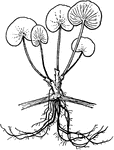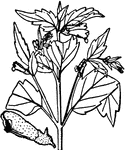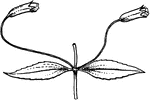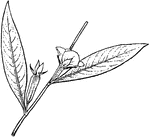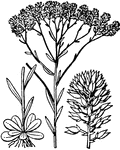
Leaves coming off a creeping or horizontal stem.

Stems 4-angled; flowers small, in dense clusters in the axils of the leaves.

Stems round, or nearly so, in cross-section; flowers showy, yellow.

Leaves with central mid-vein and smaller veins branching from this.
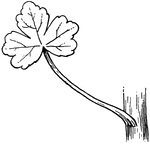
Base of petiole expanded; plants under 4 dm tall.

Base of petiole not expanded; plants large, 5 dm tall or taller.
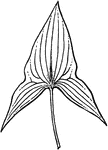
Leaves with several prominent rib-like veins running from base to apex.
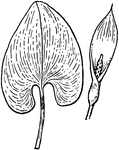
Leaves with blunt lobes; flower conspicuous, purple, not on a fleshy axis enclosed in a leaf-like sheath.
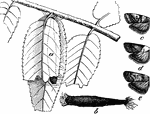
"a, leaflets attacked by a larva of A. juglandis; b, case of larva; c, wings of A. nebulo; d, wings…
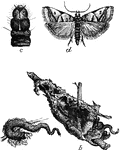
"a, case containing caterpillar; b, cases in winter; c, head and thoracic joints of larva, enlarged;…
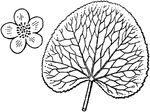
Plant small, less than 4dm tall; flowers yellow.
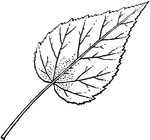
Plant large, over 5dm tall; flowers large, white, pink, or purplish.

Leaves mostly basal, heart shaped; flowers purple.

Sheaths around stem above each point of leaf-attachment; flowers white to red, not fragrant.
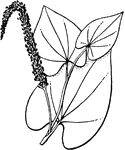
Stems with no sheaths; flowers white, fragrant.
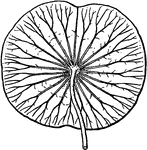
Leaves large, 2 dm or more in diameter, impossible to wet; flowers solitary, showy, yellow.

Leaves with several very prominent ribs running from base to apex.
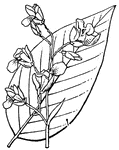
Plants white-powdery above; plants extremely large, usually over 1 m.

"Acuminate Leaf"-Whitney, 1902

Plants smaller; not wite-powdery above; leaves shed water easily; flowers along fleshy spike enclosed…

Flowers many; leaves large, over 10cm long.

Flowers solitary; leaves small, less than 5 cm long.

Leaf, when examined against light with lens, showing semitransparent dots; flowers yellow or pink.

"Acute Leaves, 'sharp at the end'"-Whitney, 1902

Flowers not showy, in axils of leaves, mostly purple.

"Adlumia cirrhosa; single leaf and panicle"-Whitney, 1902

Leaves covered with tiny black dots visible with lens; flowers small, white.
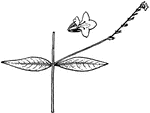
Flowers irregular, purplish.

Stems woody at least at base, arching; flowers purple-pink, in auxiliary clusters.
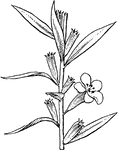
Flowers purple; plant usually corky at base.
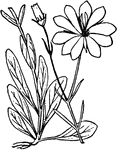
Flowers white, or, if pink, with a yellow or green eye in the center.

Flowers in terminal clusters.

Flowers small, white, gathered in dense, sessile clusters in the axils of the leaves.

Leaves small, mostly under 3cm long; usually with black dots visible with a lens covering them.

Plants decumbent at base and usually rooting at the lower nodes.

Leaves long petioled; flowers inconspicuous.
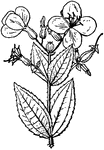
Leaves sessile or very short petioled; flowers showy.

Leaves long petioled; flowers minute, in sessile clusters on branch.
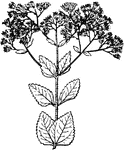
Flowers white or purplish.

Leaves large, mostly over 6 cm wide; flowers yellow, very large.

Leaves smaller; flowers individually small, in terminal spike-like clusters.
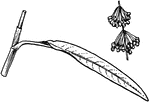
Plant with broad leaves, many basal; flowers stalked and drooping.
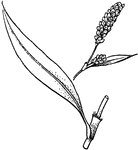
Plant with narrower leaves, none basal; flowers sessile, in terminal spikes.

Leaves not over twice as long as broad.
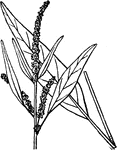
Large herb with a very stout stem, often from 1 to 3dm in diameter at base, over 1.5m tall.
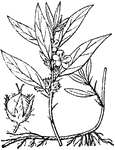
Sepals united at base into a tube enclosing the ovary and later the fruit; leaves with spines in axils.

Sepals longer than the calyx tube, reflexed.
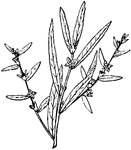
Capsule or calyx tube short and stout, not reflexed.


















